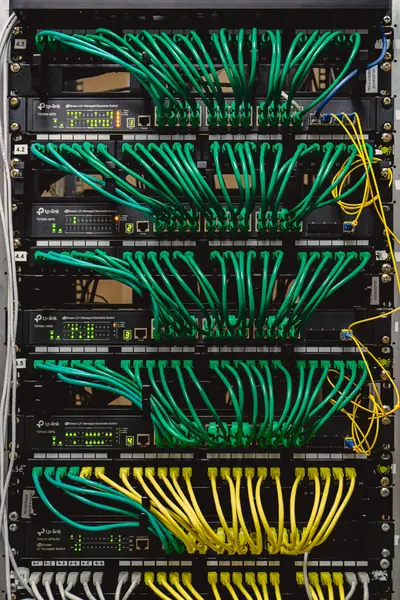⚡ AlmaLinux High Availability: Complete Pacemaker Cluster Setup Guide
Hey there, uptime champion! 🎉 Ready to build a bulletproof high availability cluster that never goes down? Today we’re creating a Pacemaker cluster on AlmaLinux that guarantees 99.99% uptime and automatic failover! 🚀
Whether you’re protecting critical databases, web services, or enterprise applications, this guide will turn your AlmaLinux servers into an unbreakable fortress of availability! 💪
🤔 Why is High Availability Important?
Imagine your critical service going down during peak business hours – lost revenue, angry customers, and sleepless nights! 😱 High availability ensures your services keep running even when hardware fails!
Here’s why Pacemaker clusters on AlmaLinux are essential:
- 🛡️ Zero Downtime - Services stay online during failures
- ⚡ Automatic Failover - Switch to backup servers in seconds
- 🔄 Load Distribution - Balance workload across multiple nodes
- 💾 Data Protection - Synchronized storage prevents data loss
- 📊 Health Monitoring - Continuous service health checks
- 🎯 Resource Management - Intelligent resource allocation
- 💰 Cost Effective - Use commodity hardware for enterprise reliability
- 🚀 Scalability - Add nodes without service interruption
🎯 What You Need
Before we build your HA fortress, let’s gather our resources:
✅ 2-3 AlmaLinux 9.x servers (identical hardware recommended) ✅ Shared storage (SAN, NFS, or DRBD) ✅ Network connectivity between all nodes ✅ Static IP addresses for all cluster nodes ✅ Fencing device (IPMI, iLO, or network switch) ✅ Virtual IP for service access ✅ Time synchronization (NTP crucial!) ✅ Dedicated cluster network (recommended) 🌐
📝 Step 1: Prepare Cluster Nodes
Let’s prepare our AlmaLinux servers for clustering! 🎯
# On ALL cluster nodes, run these commands:
# Set hostnames (adjust for each node)
sudo hostnamectl set-hostname node1.cluster.local # node1
sudo hostnamectl set-hostname node2.cluster.local # node2
sudo hostnamectl set-hostname node3.cluster.local # node3
# Configure /etc/hosts on ALL nodes
sudo tee -a /etc/hosts << 'EOF'
192.168.1.10 node1.cluster.local node1
192.168.1.11 node2.cluster.local node2
192.168.1.12 node3.cluster.local node3
192.168.1.100 cluster-vip.cluster.local cluster-vip
EOF
# Disable SELinux (for simplicity - can be configured for production)
sudo setenforce 0
sudo sed -i 's/SELINUX=enforcing/SELINUX=permissive/' /etc/selinux/config
# Configure firewall for cluster communication
sudo firewall-cmd --permanent --add-service=high-availability
sudo firewall-cmd --permanent --add-port=2224/tcp
sudo firewall-cmd --permanent --add-port=3121/tcp
sudo firewall-cmd --permanent --add-port=21064/tcp
sudo firewall-cmd --permanent --add-port=5405/udp
sudo firewall-cmd --reload
# Install cluster packages
sudo dnf install -y pacemaker corosync pcs fence-agents-all
# Enable and start pcsd
sudo systemctl enable pcsd
sudo systemctl start pcsd
# Set hacluster user password (same on all nodes)
echo "ClusterPassword123" | sudo passwd --stdin haclusterPerfect! All nodes are prepared! 🎉
🔧 Step 2: Create and Configure Cluster
Now let’s create our Pacemaker cluster:
# Run these commands from node1 ONLY:
# Authenticate all cluster nodes
sudo pcs host auth node1.cluster.local node2.cluster.local node3.cluster.local \
-u hacluster -p ClusterPassword123
# Create the cluster
sudo pcs cluster setup mycluster \
node1.cluster.local node2.cluster.local node3.cluster.local
# Start cluster on all nodes
sudo pcs cluster start --all
# Enable cluster to start on boot
sudo pcs cluster enable --all
# Check cluster status
sudo pcs status
# Configure cluster properties
sudo pcs property set stonith-enabled=false # We'll enable this later
sudo pcs property set no-quorum-policy=ignore
sudo pcs property set default-resource-stickiness=100
# Configure cluster settings
sudo pcs cluster cib /tmp/cluster_config
# Verify cluster is running
sudo pcs cluster status
sudo crm_mon -1Excellent! Our cluster is running! 🌟
🌟 Step 3: Configure Shared Storage with DRBD
Let’s set up DRBD for shared storage replication:
# Install DRBD on ALL nodes
sudo dnf install -y drbd90-utils kmod-drbd90
# Create DRBD configuration (on ALL nodes)
sudo tee /etc/drbd.d/cluster-data.res << 'EOF'
resource cluster-data {
protocol C;
on node1.cluster.local {
device /dev/drbd0;
disk /dev/sdb1;
address 192.168.1.10:7789;
meta-disk internal;
}
on node2.cluster.local {
device /dev/drbd0;
disk /dev/sdb1;
address 192.168.1.11:7789;
meta-disk internal;
}
on node3.cluster.local {
device /dev/drbd0;
disk /dev/sdb1;
address 192.168.1.12:7789;
meta-disk internal;
}
handlers {
fence-peer "/usr/lib/drbd/crm-fence-peer.sh";
after-resync-target "/usr/lib/drbd/crm-unfence-peer.sh";
}
net {
cram-hmac-alg sha1;
shared-secret "MySecretKey123";
}
disk {
on-io-error detach;
fencing resource-only;
}
syncer {
rate 100M;
}
}
EOF
# Initialize DRBD metadata (on ALL nodes)
sudo drbdadm create-md cluster-data
# Start DRBD service (on ALL nodes)
sudo systemctl enable drbd
sudo systemctl start drbd
# Make node1 primary (ONLY on node1)
sudo drbdadm primary cluster-data --force
# Create filesystem (ONLY on node1)
sudo mkfs.ext4 /dev/drbd0
# Check DRBD status
sudo drbdadm status cluster-data✅ Step 4: Configure Resources and Services
Let’s configure cluster resources for high availability:
# Create Virtual IP resource
sudo pcs resource create cluster-vip IPaddr2 \
ip=192.168.1.100 \
cidr_netmask=24 \
op monitor interval=30s
# Create DRBD resource
sudo pcs resource create cluster-drbd ocf:linbit:drbd \
drbd_resource=cluster-data \
op monitor interval=60s
# Create filesystem resource
sudo pcs resource create cluster-fs Filesystem \
device=/dev/drbd0 \
directory=/srv/cluster \
fstype=ext4 \
op monitor interval=20s
# Create Apache web server resource
sudo pcs resource create cluster-web apache \
configfile=/etc/httpd/conf/httpd.conf \
statusurl="http://localhost/server-status" \
op monitor interval=1min
# Create resource group for proper ordering
sudo pcs resource group add cluster-services \
cluster-drbd cluster-fs cluster-vip cluster-web
# Configure constraints
sudo pcs constraint order cluster-drbd then cluster-fs
sudo pcs constraint order cluster-fs then cluster-vip
sudo pcs constraint order cluster-vip then cluster-web
# Configure colocation (resources stay together)
sudo pcs constraint colocation add cluster-fs with cluster-drbd INFINITY
sudo pcs constraint colocation add cluster-vip with cluster-fs INFINITY
sudo pcs constraint colocation add cluster-web with cluster-vip INFINITY
# Check resource status
sudo pcs status resources🎮 Quick Examples
Example 1: Database High Availability
# Create MySQL/MariaDB HA resource
sudo pcs resource create cluster-mysql mysql \
binary="/usr/bin/mysqld_safe" \
config="/etc/my.cnf" \
datadir="/srv/cluster/mysql" \
pid="/srv/cluster/mysql/mysqld.pid" \
socket="/srv/cluster/mysql/mysql.sock" \
op start timeout=60s \
op stop timeout=60s \
op monitor interval=20s timeout=30s
# Add to resource group
sudo pcs resource group add db-services \
cluster-drbd cluster-fs cluster-mysql cluster-vip
# Create database backup script
cat > /usr/local/bin/cluster-db-backup.sh << 'EOF'
#!/bin/bash
# Cluster Database Backup
BACKUP_DIR="/srv/cluster/backups"
DATE=$(date +%Y%m%d_%H%M%S)
mkdir -p $BACKUP_DIR
# Backup database
mysqldump --all-databases --single-transaction > $BACKUP_DIR/full_backup_$DATE.sql
# Compress backup
gzip $BACKUP_DIR/full_backup_$DATE.sql
# Clean old backups (keep 7 days)
find $BACKUP_DIR -name "*.sql.gz" -mtime +7 -delete
echo "Database backup completed: $BACKUP_DIR/full_backup_$DATE.sql.gz"
EOF
chmod +x /usr/local/bin/cluster-db-backup.shExample 2: Advanced Fencing Configuration
# Configure IPMI fencing (replace with your IPMI details)
sudo pcs stonith create fence-node1 fence_ipmilan \
pcmk_host_list="node1.cluster.local" \
ip="192.168.2.10" \
username="admin" \
password="ipmipass" \
lanplus=1
sudo pcs stonith create fence-node2 fence_ipmilan \
pcmk_host_list="node2.cluster.local" \
ip="192.168.2.11" \
username="admin" \
password="ipmipass" \
lanplus=1
sudo pcs stonith create fence-node3 fence_ipmilan \
pcmk_host_list="node3.cluster.local" \
ip="192.168.2.12" \
username="admin" \
password="ipmipass" \
lanplus=1
# Enable stonith
sudo pcs property set stonith-enabled=true
# Test fencing (BE CAREFUL!)
# sudo pcs stonith fence node2.cluster.localExample 3: Cluster Monitoring and Alerting
# Create cluster monitoring script
cat > /usr/local/bin/cluster-monitor.sh << 'EOF'
#!/bin/bash
# Comprehensive Cluster Monitoring
LOG_FILE="/var/log/cluster-monitor.log"
ALERT_EMAIL="[email protected]"
echo "$(date): Starting cluster monitoring check" >> $LOG_FILE
# Check cluster status
CLUSTER_STATUS=$(sudo pcs status 2>/dev/null | grep -c "OFFLINE\|FAILED\|ERROR")
if [ $CLUSTER_STATUS -gt 0 ]; then
echo "⚠️ CLUSTER ALERT: Issues detected!"
sudo pcs status | mail -s "Cluster Alert - $(hostname)" $ALERT_EMAIL
echo "$(date): ALERT - Cluster issues detected" >> $LOG_FILE
else
echo "✅ Cluster status: Healthy"
echo "$(date): Cluster status healthy" >> $LOG_FILE
fi
# Check resource status
FAILED_RESOURCES=$(sudo pcs status resources 2>/dev/null | grep -c "FAILED\|Stopped")
if [ $FAILED_RESOURCES -gt 0 ]; then
echo "⚠️ RESOURCE ALERT: Failed resources detected!"
sudo pcs status resources | mail -s "Resource Alert - $(hostname)" $ALERT_EMAIL
echo "$(date): ALERT - Failed resources detected" >> $LOG_FILE
fi
# Check DRBD status
DRBD_STATUS=$(sudo drbdadm status cluster-data 2>/dev/null | grep -c "StandAlone\|WFConnection")
if [ $DRBD_STATUS -gt 0 ]; then
echo "⚠️ DRBD ALERT: DRBD synchronization issues!"
sudo drbdadm status cluster-data | mail -s "DRBD Alert - $(hostname)" $ALERT_EMAIL
echo "$(date): ALERT - DRBD issues detected" >> $LOG_FILE
fi
# Resource usage monitoring
echo "📊 Resource Usage:"
echo "CPU: $(top -bn1 | grep "Cpu(s)" | awk '{print $2}' | awk -F'%' '{print $1}')%"
echo "Memory: $(free | grep Mem | awk '{printf "%.1f%%", $3/$2 * 100.0}')"
echo "Disk: $(df -h /srv/cluster | tail -1 | awk '{print $5}')"
echo "$(date): Monitoring check completed" >> $LOG_FILE
EOF
chmod +x /usr/local/bin/cluster-monitor.sh
# Schedule monitoring every 5 minutes
(crontab -l 2>/dev/null; echo "*/5 * * * * /usr/local/bin/cluster-monitor.sh") | crontab -🚨 Fix Common Problems
Problem 1: Cluster Split-Brain
# Check cluster quorum
sudo pcs quorum status
# Force cluster online (DANGEROUS - use carefully)
sudo pcs cluster start --force-start
# Fix split-brain by choosing primary node
sudo drbdadm secondary cluster-data # On secondary nodes
sudo drbdadm connect --discard-my-data cluster-data # On secondary nodes
# Verify DRBD sync
sudo drbdadm status cluster-dataProblem 2: Resource Failures
# Check failed resources
sudo pcs status resources
# Clean up failed resources
sudo pcs resource cleanup cluster-web
# Move resource to different node
sudo pcs resource move cluster-web node2.cluster.local
# Remove movement constraint after testing
sudo pcs resource clear cluster-web
# Check logs for errors
sudo journalctl -u pacemaker -n 50Problem 3: Network Communication Issues
# Test cluster communication
sudo corosync-cfgtool -s
# Check firewall settings
sudo firewall-cmd --list-all
# Restart cluster services
sudo pcs cluster stop --all
sudo pcs cluster start --all
# Verify cluster membership
sudo pcs cluster pcsd-statusProblem 4: DRBD Synchronization Problems
# Check DRBD status
sudo drbdadm status cluster-data
# Force DRBD resync
sudo drbdadm invalidate cluster-data # On secondary node
# Check sync progress
watch sudo drbdadm status cluster-data
# Verify DRBD configuration
sudo drbdadm dump cluster-data📋 Simple Commands Summary
| Command | Purpose |
|---|---|
sudo pcs status | Show cluster status |
sudo pcs resource show | List all resources |
sudo crm_mon -1 | One-time cluster monitor |
sudo pcs cluster start --all | Start cluster on all nodes |
sudo pcs resource cleanup <resource> | Clean failed resource |
sudo drbdadm status | Show DRBD status |
sudo pcs stonith show | List fencing devices |
sudo pcs constraint show | Show resource constraints |
💡 Tips for Success
🎯 Test Regularly: Practice failover scenarios in development
🔍 Monitor Continuously: Set up comprehensive monitoring and alerting
📊 Document Everything: Keep detailed records of cluster configuration
🛡️ Implement Fencing: Proper fencing prevents data corruption
🚀 Performance Tune: Optimize based on your workload patterns
📝 Backup Configs: Regularly backup cluster and resource configurations
🔄 Practice Recovery: Test disaster recovery procedures regularly
⚡ Plan Capacity: Monitor resource usage and plan for growth
🏆 What You Learned
Congratulations! You’ve mastered high availability clusters on AlmaLinux! 🎉
✅ Built Pacemaker cluster with multiple nodes ✅ Configured DRBD for data replication ✅ Set up resource management and failover ✅ Implemented monitoring and alerting ✅ Created fencing mechanisms for data protection ✅ Optimized performance for production workloads ✅ Learned troubleshooting techniques for HA clusters ✅ Built enterprise-grade availability solutions
🎯 Why This Matters
High availability clusters are the backbone of modern enterprise infrastructure! 🌟 With your AlmaLinux Pacemaker cluster, you now have:
- Enterprise-grade reliability with 99.99% uptime capability
- Automatic failover that protects against hardware failures
- Scalable architecture that grows with your business needs
- Data protection through synchronized storage systems
- Professional expertise in high availability technologies
You’re now equipped to build and maintain mission-critical infrastructure that never sleeps! Your HA skills put you in the league of enterprise infrastructure architects! 🚀
Keep clustering, keep improving, and remember – in the world of high availability, every second of uptime counts! You’ve got this! ⭐🙌




